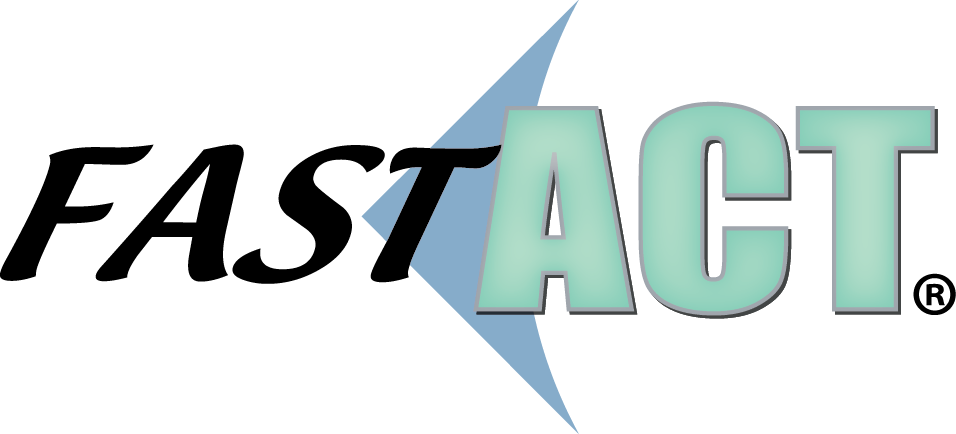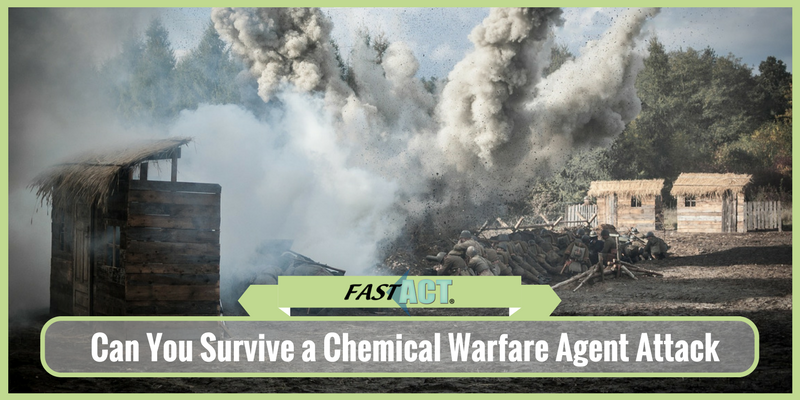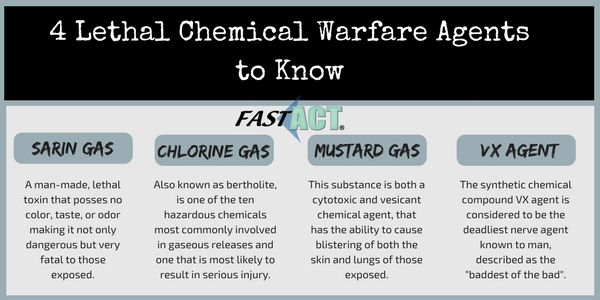Chemical warfare has gained an increasing notoriety in recent years as chemical warfare agent attacks have grown in number, especially in countries like Syria who has experienced devastation at the hands of these deadly warfare agents. Chemical warfare agents are defined as any chemical substance whose toxic properties are used to kill, injure, or debilitate an enemy in warfare. Nevertheless, when these toxic chemical agents are used on masses of unarmed civilians that have no protection from these chemical warfare agents the complete wreckage can be insurmountable.
The long history of chemical agent use dates back as far as before World War I, where it reached its peak. Many countries even began developing a stockpiling of these agents in the preparation of war, after seeing the magnitude of wreckage that could be caused by the use of these agents. However, with these deadly agents freely possessed by different countries worldwide, the need to have a plan of preparation and awareness of the impact of different types of lethal chemical warfare agents has become necessary. Furthermore, having access to the necessary resources and information can better equip you to be able to survive a chemical warfare agent attack if ever faced with these dangerous agents in your environment.
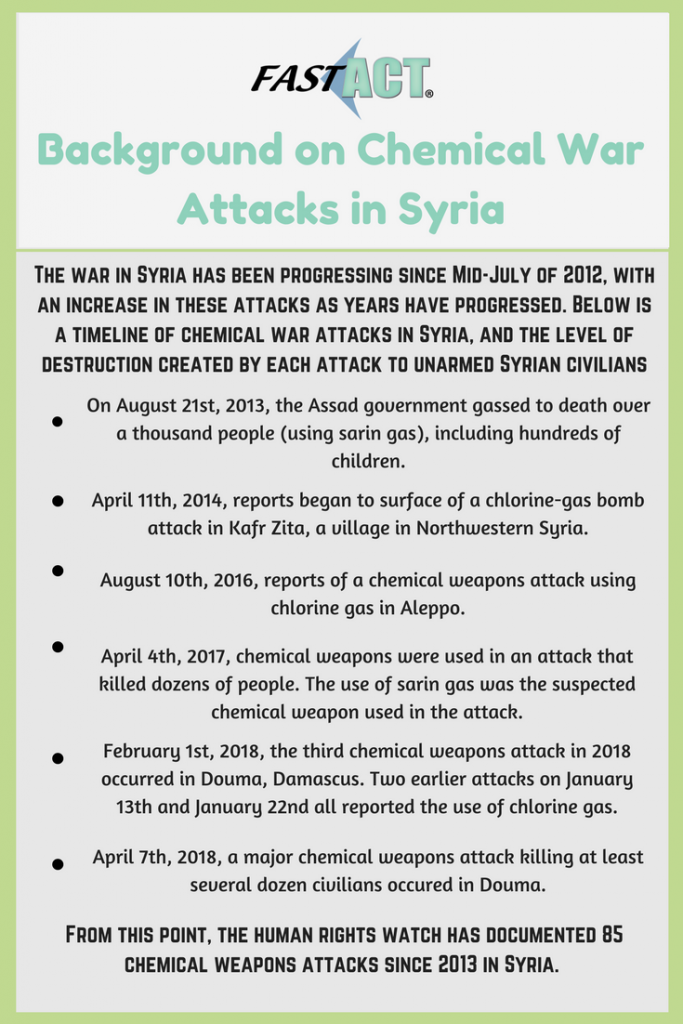 Background on Chemical War Attacks in Syria
Background on Chemical War Attacks in Syria
The use of chemical war agents in Syria have been occurring since 2012, with an increase in these attacks as years have progressed. Below is a timeline of chemical war attacks in Syria, and the level of destruction created by each attack to unarmed Syrian civilians.
- The war in Syria has been progressing since Mid-July of 2012, the time of the first acknowledgment from the Syria government that they possessed chemical weapons such as mustard gas, blister agents, and nerve agents such as sarin and VX gases.
- On August 21st, 2013, the Assad government gassed to death over a thousand people (using sarin gas), including hundreds of children.
- April 11th, 2014, reports began to surface of a chlorine-gas bomb attack in Kafr Zita, a village in Northwestern Syria.
- August 10th 2016, reports of a chemical weapons attack using chlorine gas in Aleppo.
- April 4th, 2017, Chemical weapons were used in an attack that killed dozens of people. The use of sarin gas was the suspected chemical weapon used in the attack.
- February 1st, 2018, the third chemical weapon attack in 2018 occurred in Douma, Damascus. Two earlier attacks on January 13th and January 22nd all reported used chlorine gas.
- April 7th, 2018, a major chemical weapons attack killing at least several dozen civilians occurred in Douma.
- From this point, the Human Rights Watch has documented 85 chemical weapons attacks since 2013 in Syria.
*Reported by Arms Control Association (Timeline of Syrian Chemical Weapons Activity, 2012-2018)
As time progresses the threats and level of danger in Syria is at an all-time high. With over 1,000’s of unarmed civilians injured or killed in the careless acts of war, the dangers of chemical warfare agents have grown for all citizens who want to be prepared.
Chemical Attack Symptoms
When dealing with exposure to chemical warfare agents, depending on the type of exposure the symptoms can range from situation to situation.
- Liquid exposure can easily penetrate the skin and clothing and symptoms can begin starting as soon as 30 minutes after exposure. Symptoms include:
- Sweating
- Muscle Twitching
- Nausea
- Vomiting
- Diarrhea
- Difficulty breathing
- Vapor exposure symptoms can occur within seconds after its release into the environment.
- Blurred vision
- Eye pain
- Red eyes
- A runny nose
- Difficulty breathing, shortness of breath
- Other symptoms include:
- Respiratory tract symptoms
- Headaches
- Dizziness
- Numbness
- Difficulty walking
4 Lethal Chemical Warfare Agents to Know
Chemical warfare agents all possess some defining qualities that have proven to be dangerous to humans in some capacity. However, some chemical warfare agents are more lethal than others especially when distributed in large amounts in the environment. The top lethal chemical warfare agents that are not only extremely dangerous but also very commonly used in chemical wars include sarin gas, chlorine gas, mustard gas and VX agent.
Sarin Gas
A long used chemical warfare agent, sarin gas is a man-made, lethal toxin that possesses no color, taste, or odor making it not only dangerous but very fatal to those exposed. This nerve gas is often times released into the air in either vapor spray or aerosol form, deployed on the intended targeted area. Sarin, although produced as a liquid, due to its low evaporation point, it allows it to turn into a gas quickly when exposed to the environment and spread rapidly throughout the area. Because sarin gas is colorless and not easily detected in the environment, it is very difficult for people to know whether or not they have been exposed to this nerve agent. Thus, keeping an eye out for symptoms is important, these symptoms may include a runny nose, eye pain, drooling, excessive sweating, rapid breathing, coughing, increased urination, and nausea according to the Center for Disease Control and Prevention (CDC). In even more extreme circumstances loss of consciousness, paralysis, convulsions, and respiratory failure could occur.
Sarin was first created in the late 1930s by a German chemist, Gerhard Schrader. Schrader originally developed this nerve agent to be a pesticide but as Schrader kept developing this agent it was able to effectively render him blind and even made him lose most of his muscular coordination. Therefore, after seeing its capability and witnessing the potential destruction that it could ignite, the German military acquired this agent (they referred to it as GB) as a means for deploying and rendering their enemy harm. As more and more militaries began to obtain this chemical warfare agent, stockpiling this chemical started to become a norm for many countries. Ultimately, this leads to the outlaw of Sarin in 1997 by the United Nations’ Chemical Weapons Convention of 1993. Today, recent chemical attacks in Syria have used this deadly agent, with the attack in 2013 in Ghouta, Syria being the most lethal use of chemicals in global warfare since the 1988 Halabja Massacre.
Chlorine Gas
Chlorine gas (ChG), also known as bertholite, is one of the ten hazardous chemicals most commonly involved in gaseous releases, and that one that is most likely to result in death or human injury. Once the gas is released into the air, those exposed may start to experience a smell similar to pepper and pineapple in the air, followed by a metallic taste in their mouth. When chlorine gas is inhaled in low concentrations you may start to experience symptoms similar to mild irritation of mucous membranes, coughing, choking and shortness of breath. And when exposed to high concentrations, more severe symptoms such as damage to the respiratory tract, and other life-threating ailments could occur.
This gas is another chemical agent with a long history of use going back almost 100 years. Chlorine gas was used during World War I and even used by the German Army during the Second Battle of Ypres in Belgium. When chlorine is released as a gas, it stays closer to the ground and spreads quickly, making it ideal for warfare and terrorism as they aim for those on the ground to impact. Although this gas is arguably less deadly than sarin or mustard gas because of its ability to be filtered out with a gas mask, many civilians are not equipped with this type of protection. Finding an effect air-purifying respirator mask that you can have on hand if a chemical attack occurs could be vital to your overall health. The FAST-ACT VapourKlenz Face Mask is ideal for chemical warfare situations especially those that use chlorine gas. FAST-ACT uses a proprietary technology that is extremely effective at neutralizing a broad spectrum of chemicals and odors that come into contact with the technology, including chemical warfare agents in the environment. The FAST-ACT VapourKlenz Face Mask is ideal for chemical vapors and gases that are released into the environment, with a filtration piece in the front of the mask with the FAST-ACT technology, it will filter out any chemicals that try to pass through the filter.
Mustard Gas
Mustard gas (or sulfur mustard) is a chemical weapon that originated with World War I trench warfare. This substance is both a cytotoxic and vesicant chemical agent, that has the ability to cause blistering of both the skin and lungs of those exposed. Mustard gas can be absorbed through inhalation, ingestion, or by contact with the skin or eyes. Victims of mustard gas exposure will rarely experience symptoms on the onset, so many are unknowingly exposed to high amounts without knowing so, which could leave them to believe they are completely fine. One of the first indicators tends to be an overwhelming odor similar to mustard plants, garlic, or horseradish. Soon intense itching will take place over the period of 24 hours following mustard gas exposure.
Mustard gas was first used on the battlefields of the Second Battle of Ypres, where the German Army unleashed the first large-scale use of poison gas as a weapon on the battlefield. Since World War II, there have been sporadic deployments of mustard gas and other chemical agents. In recent, the use of Mustard gas has been deployed during the civil war in Syria, thus bringing the attention back to the dangers of Mustard gas on the health of those exposed.
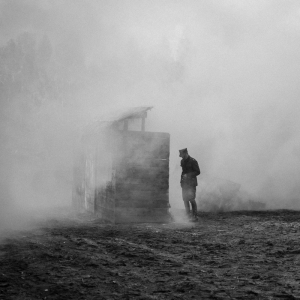 VX Agent
VX Agent
The synthetic chemical compound VX agent is considered to be the deadliest nerve agent known to man, described as the “baddest of the bad”. VX agent, or “Venomous agent x” is extremely toxic and has the potential to kill very quickly, although it is rarely used. Even worse, is the amount of time that is required for the substance to evaporate, as it evaporates extremely slow and persists in the environment it was used in for quite some time after it’s deployed. Once VX agent is administered, either by direct spray or by poisoning food or water, victims exposed will start experiencing violent convulsions, followed by unconscious paralysis, and finally death in extreme cases.
The best way to describe this chemical warfare agent is as a “pesticide for people” as it will gradually make the body tired and eventually suffocating the body. The substance can be very silent as it is completely odorless and tasteless, typically resembling an oily, yellowish-brown liquid. In the wrong hands and with the right devices, this nerve agent can lead to an insurmountable number of casualties.
How to Protect Yourself from Chemical Warfare
The planning process for a potential chemical warfare attack is not only important but can be somewhat of a challenge to begin. It is difficult to pinpoint exactly where to start in your preparations. Thus, our guide can help you to gain more insight and clarity on how to prepare yourself and your family in the event of a chemical warfare attack in your environment.
- Layout an Evacuation Plan: When a chemical warfare agent is deployed in your environment, you will want to have an exit plan in place. Getting as far away from the tainted environment is critical, so try to flee as quickly and safely as possible. If you have children or even a spouse, you need to have a plan in place that you both are aware of in case you happen to be separated from each other. Have a designated meeting place selected that you can meet them at so that you can reunite safely to flee.
- Seek Higher Ground: Sarin and chlorine gases are denser than air, which makes them sink lower to the ground. In this case, you will want to go to higher grounds to provide yourself with less exposure to the released chemical agent.
- Chemical Protection Gear: FAST-ACT uses a proprietary technology that integrates “destructive adsorption” technologies into customer-driven applications. FAST-ACT works on a broad spectrum of chemicals and odors in the environment, include toxic chemical warfare agents, having the ability to decontaminate and neutralize the chemical at the source. With the FAST-ACT Chemical Decontamination Kit, FAST-ACT provides the prepper with a solution and resource to all chemical releases in your environment. The chemical attack survival kit includes the following:
- FAST-ACT Decon Mitt (4 Mitts)
- FAST-ACT Sorbent Powder Bottle Set
- FAST-ACT Microfiber Towel Set
- FAST-ACT VapourKlenz Face Masks (3)
- User Manual and product information
